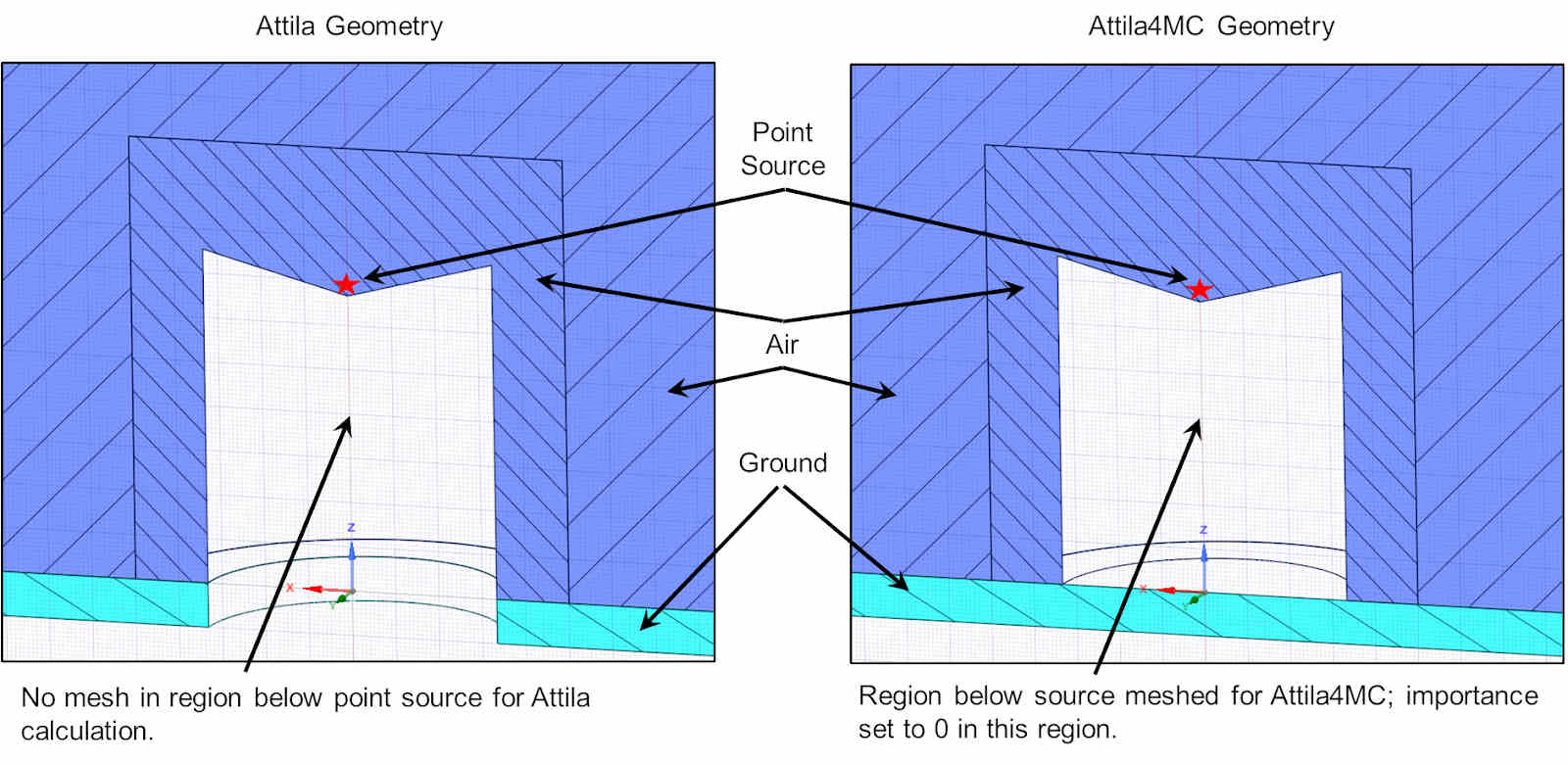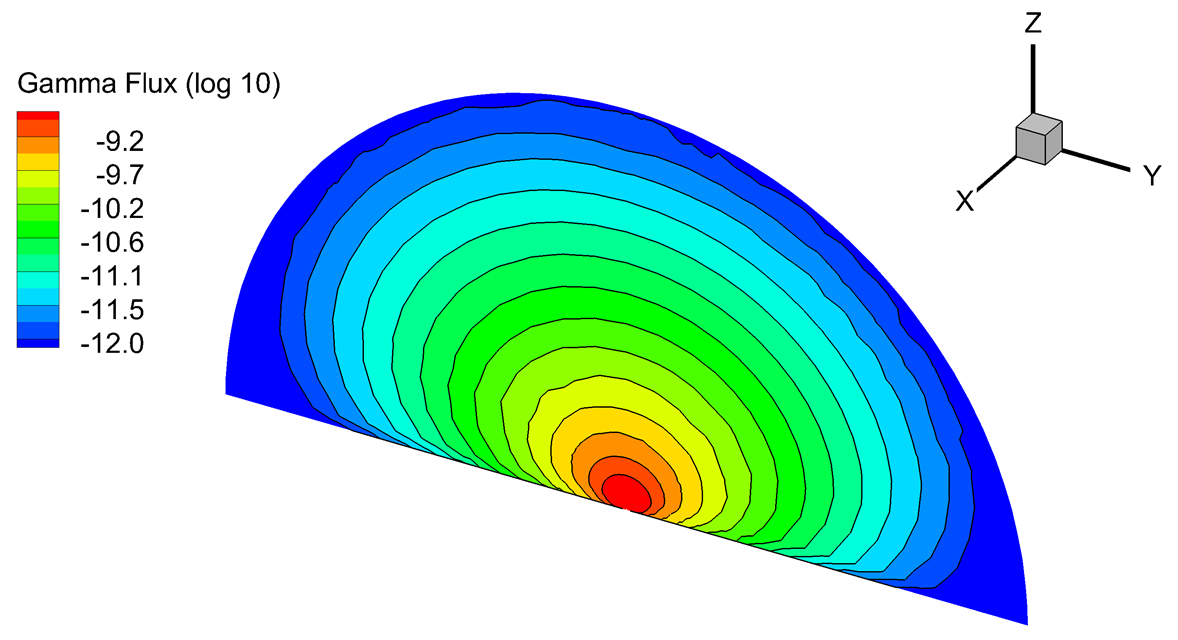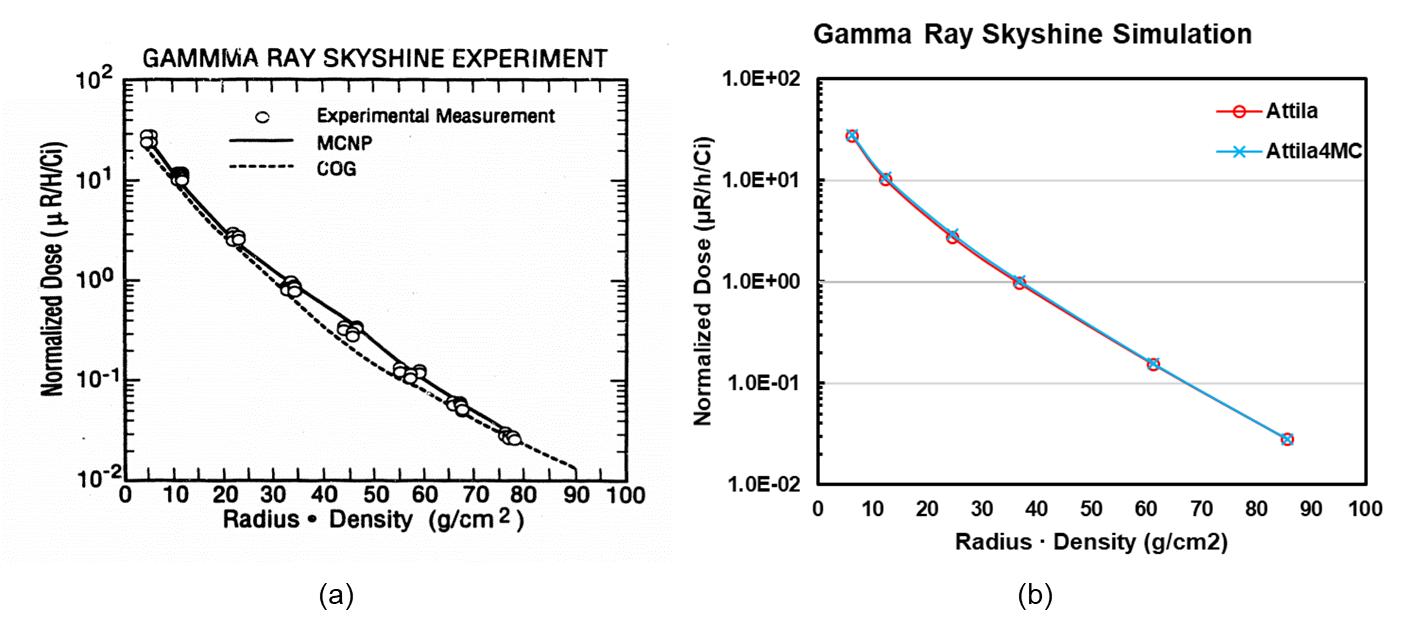Calculations were performed with both the deterministic Attila solver and MCNP® using Attila4MC (referred to herein as Attila4MC) simulating a benchmark calculation from the LA-UR-90-3951 report “Monte Carlo Photon Benchmark Problems” [1]. A 60Co skyshine experiment was reproduced by placing an isotropic point source in an air hemisphere and collimating it into upward facing cone. Point detector results were generated using Attila and Attila4MC. Graphical results from the original report were included for comparison.
Note that Scale Factors of 10 were applied in the Attila Mesh Generator (located in the Advanced options). The isotropic point source is located on the Z-axis of an air hemisphere 200 cm above the ground. The point source is collimated through a 150.5° upward facing cone into the air, as seen in Figure 1. A 30 cm thick layer of ground material is modeled to account for backscatter into the air. The air hemisphere has a radius of 180000 cm. Ring detectors are located 100 cm above the ground at radial distances of 5000, 10000, 20000, 30000, 50000, and 70000 cm from the Z-axis. A 90-point ring set is used for the deterministic Attila solver calculations.

Figure 1. XZ-cross section of Attila (left) and Attila4MC (right) geometries showing the point source locations (red star). The point sources are collimated through a 150.5° upward facing cone into the air.
Collimation of the point source is handled through different solid geometries for Attila and Attila4MC. As shown in Figure 1 (left), the ground geometry in Attila is removed below the point source. This prevents an Empty Region from being created when loading the solid geometry into the mesh generator. In the solid geometry used by Attila4MC (right), the ground geometry is removed, resulting in an Empty Region being created below the point source. This region is assigned an importance of 0. Both approaches ensure that no primary (uncollided) particles from the source reach the detectors.
The computational mesh for the deterministic Attila solver calculations contains 193501 elements, and the mesh for the Attila4MC calculations contains 194538 elements. Deterministic Attila solver calculations use the Transpire46g cross section set (46 gamma groups) in which all fine gamma groups above 1.35 MeV (the highest source energy group) are unassigned, and all groups below 1.00 MeV (the lowest source energy group) are collapsed by two. An SN order of 18 and a Pn order of 3 are used.
A flux-to-dose conversion factor is used for Attila and Attila4MC to obtain dose in units of µR h-1 Ci-1 assuming a normalized total source strength of 1 particle s-1. The Attila calculation is performed using the First Scattered Distributed Source (FSDS) capability. Through the FSDS feature, the uncollided and collided (scattered) components of the solution are separately calculated, then merged to obtain the total flux solution. However, only the collided component is of interest in this calculation. Instead of using the last collided method, a ring of points is created at radial distances of interest and the average flux for all points is calculated. This technique smooths the flux solution at each point, as the linear solution in the large air cells (mesh elements) may not be able to be used to accurately calculate the scalar flux at a single point. Alternatively, the last collided method can be used to calculate the flux at each point, but this approach is computationally expensive. Table 1 shows which calculations provide results for the various methods employed.

Table 1. Calculation File Index
Deterministic Attila solver calculations are run through the FSDS object in the GUI, labelled Run1-Attila-FSDS, which references the base Attila calculation, Run1-Attila. The Attila calculation results are located in the Run1-Attila-FSDS subdirectory, and separately include the uncollided (*uncol.) and collided (*coll.) components. The uncollided (unscattered) flux is expected to be equal to zero.
The computational mesh for the deterministic Attila solver calculations contains 193501 elements, and the mesh for the Attila4MC calculations contains 194538 elements. Deterministic Attila solver calculations use the Transpire46g cross section set (46 gamma groups) in which all fine gamma groups above 1.35 MeV (the highest source energy group) are unassigned, and all groups below 1.00 MeV (the lowest source energy group) are collapsed by two. An SN order of 18 and a Pn order of 3 are used.
Contour plots of the and scattered flux for the deterministic Attila solver calculations are provided in Figure 2.

Figure 2. Contour plots of the scattered flux for the deterministic Attila solver calculations.
Table 2 shows dose results for point detectors using Attila and Attila4MC. Attila4MC calculations were run to convergence with a relative error of less than 5% (1.00E+06 histories). Ratios of Attila to Attila4MC (Attila/Attila4MC) results are included.

Table 2. Point Detector Dose Results (µR h-1 Ci-1, normalized)
Figure 3 shows graphical results from the original report (a) taken from [1] and a recreation of the plot using data from Table 2. Normalized dose is plotted as a function of radial location times the density of air (assumed 0.001225 g cm-3).

Figure 3. Normalized dose as a function of radial location and air density for the original report results (a) and the results obtained using Attila and Attila4MC (b).